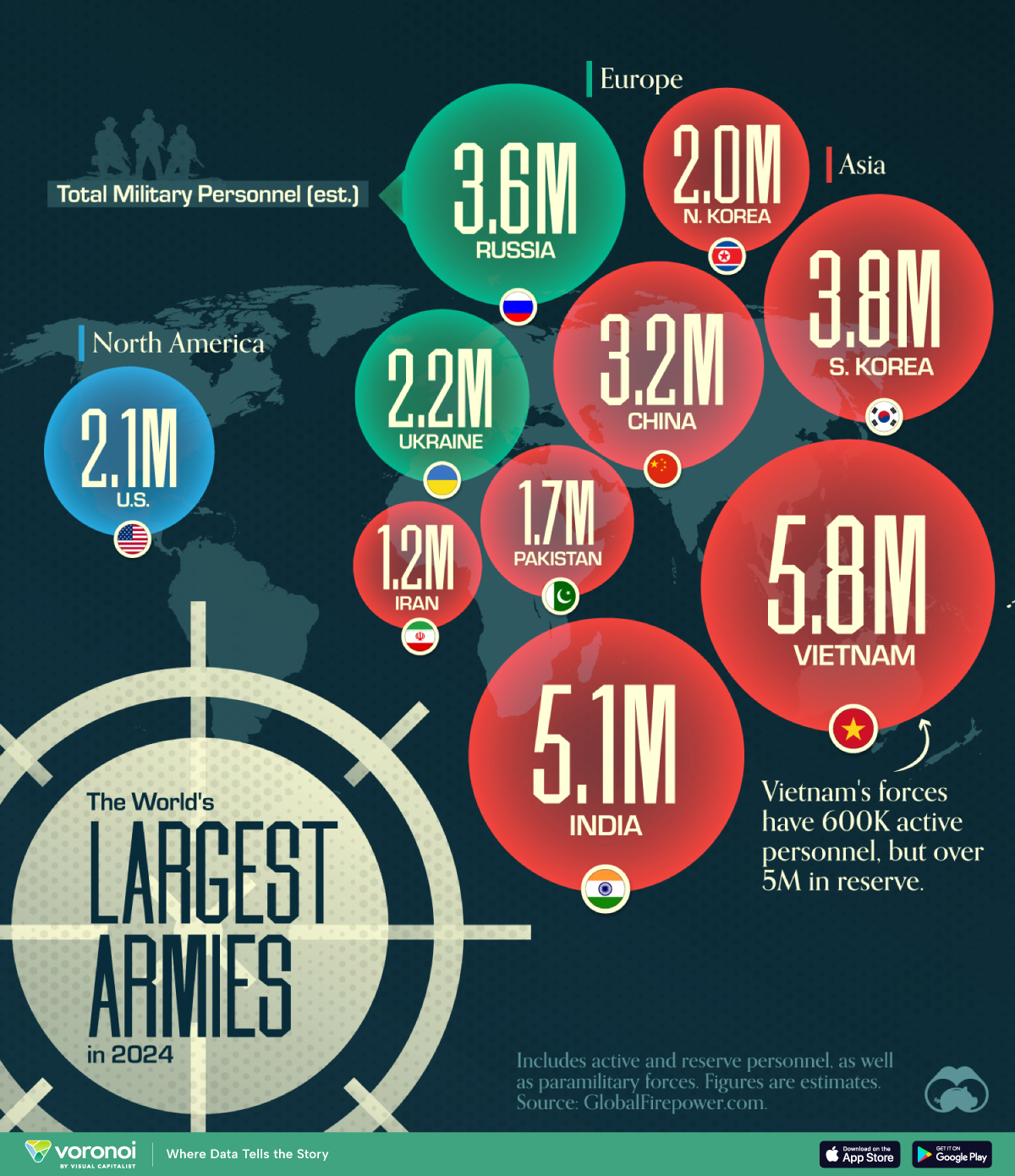Politics
Mapped: Which Countries Still Have a Monarchy?
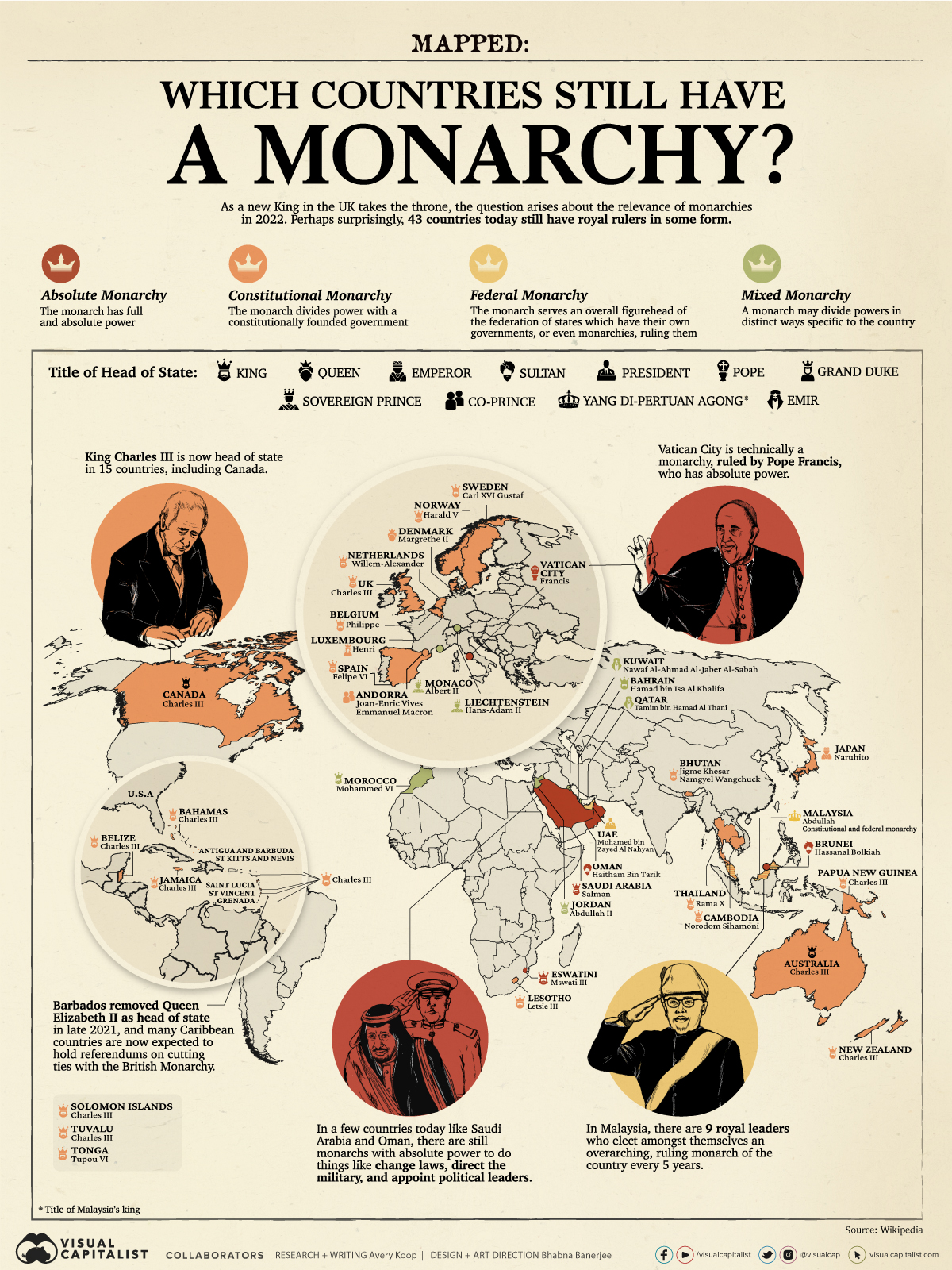
Mapped: Which Countries Still Have a Monarchy?
In the wake of Queen Elizabeth II’s death, the question of monarchy is brought sharply into focus.
However, a surprising number of countries have ruling monarchs, and in this visual we break down the kinds of royal leadership across the 43 countries that still have them.
Types of Monarchies
A monarch in the simplest sense is a country’s king, queen, emir, or sultan, and so on. But before diving in, it’s important to break down the distinctions between the types of monarchies that exist today. Generally, there are four kinds:
① Constitutional Monarchy
The monarch divides power with a constitutionally founded government. In this situation, the monarch, while having ceremonial duties and certain responsibilities, does not have any political power. For example, the UK’s monarch must sign all laws to make them official, but has no power to change or reject new laws.
Here are some examples of countries with constitutional monarchies:
🇯🇵 Japan
🇬🇧 United Kingdom
🇩🇰 Denmark
② Absolute Monarchy
The monarch has full and absolute political power. They can amend, reject, or create laws, represent the country’s interests abroad, appoint political leaders, and so on.
Here are some examples of countries with absolute monarchies:
🇸🇿 Eswatini
🇸🇦 Saudi Arabia
🇻🇦 Vatican City
③ Federal Monarchy
The monarch serves an overall figurehead of the federation of states which have their own governments, or even monarchies, ruling them.
Here are some examples of countries with federal monarchies:
🇦🇪 UAE
🇲🇾 Malaysia
Malaysia is a unique form of federal monarchy. Every five years, each state’s royal leaders choose amongst themselves who will be the monarch, or the Yang di-Pertuan Agong, of Malaysia and the respective states. Furthermore, the monarchy is also constitutional, allowing a democratically elected body to govern.
④ Mixed Monarchy
This is a situation wherein an absolute monarch may divide powers in distinct ways specific to the country.
Here are some examples of countries with mixed monarchies:
🇯🇴 Jordan
🇱🇮 Liechtenstein
🇲🇦 Morocco
Interestingly, Liechtenstein is the only European monarchy that still practises strict agnatic primogeniture. Under agnatic primogeniture, the degree of kinship is determined by tracing descent from the nearest common ancestor through male ancestors.
Kings, Queens, Emperors, and Sultans Around the Globe
Now let’s break down the different monarchies country by country:
| Country | Type of Monarchy | Title of Head of State | Monarch | Title of Head of Government |
|---|---|---|---|---|
| 🇦🇩 Andorra | Constitutional | Co-Princes | Joan-Enric Vives, Emmanuel Macron | Prime Minister |
| 🇦🇬 Antigua and Barbuda | Constitutional | King | Charles III | Prime Minister |
| 🇦🇺 Australia | Constitutional | King | Charles III | Prime Minister |
| 🇧🇭 Bahrain | Mixed | King | Hamad bin Isa Al Khalifa | Prime Minister |
| 🇧🇪 Belgium | Constitutional | King | Philippe | Prime Minister |
| 🇧🇿 Belize | Constitutional | King | Charles III | Prime Minister |
| 🇧🇹 Bhutan | Constitutional | King | Jigme Khesar Namgyel Wangchuck | Prime Minister |
| 🇧🇳 Brunei Darussalam | Absolute | Sultan | Hassanal Bolkiah | Sultan |
| 🇰🇭 Cambodia | Constitutional | King | Norodom Sihamoni | Prime Minister |
| 🇨🇦 Canada | Constitutional | King | Charles III | Prime Minister |
| 🇩🇰 Denmark | Constitutional | Queen | Margrethe II | Prime Minister |
| 🇸🇿 Eswatini | Absolute | King | Mswati III | Prime Minister |
| 🇬🇩 Grenada | Constitutional | King | Charles III | Prime Minister |
| 🇯🇲 Jamaica | Constitutional | King | Charles III | Prime Minister |
| 🇯🇵 Japan | Constitutional | Emperor | Naruhito | Prime Minister |
| 🇯🇴 Jordan | Mixed | King | Abdullah II | Prime Minister |
| 🇰🇼 Kuwait | Mixed | Emir | Nawaf Al-Ahmad Al-Jaber Al-Sabah | Prime Minister |
| 🇱🇸 Lesotho | Constitutional | King | Letsie III | Prime Minister |
| 🇱🇮 Liechtenstein | Mixed | Sovereign Prince | Hans-Adam II | Prime Minister |
| 🇱🇺 Luxembourg | Constitutional | Grand Duke | Henri | Prime Minister |
| 🇲🇾 Malaysia | Constitutional & Federal | Yang di-Pertuan Agong | Abdullah | Prime Minister |
| 🇲🇨 Monaco | Mixed | Sovereign Prince | Albert II | Minister of State |
| 🇲🇦 Morocco | Mixed | King | Mohammed VI | Prime Minister |
| 🇳🇱 Netherlands | Constitutional | King | Willem-Alexander | Prime Minister |
| 🇳🇿 New Zealand | Constitutional | King | Charles III | Prime Minister |
| 🇳🇴 Norway | Constitutional | King | Harald V | Prime Minister |
| 🇴🇲 Oman | Absolute | Sultan | Haitham bin Tarik | Sultan |
| 🇵🇬 Papua New Guinea | Constitutional | King | Charles III | Prime Minister |
| 🇶🇦 Qatar | Mixed | Emir | Tamim bin Hamad Al Thani | Prime Minister |
| 🇰🇳 Saint Kitts and Nevis | Constitutional | King | Charles III | Prime Minister |
| 🇱🇨 Saint Lucia | Constitutional | King | Charles III | Prime Minister |
| 🇻🇨 Saint Vincent and the Grenadines | Constitutional | King | Charles III | Prime Minister |
| 🇸🇦 Saudi Arabia | Absolute | King | Salman | Prime Minister |
| 🇸🇧 Solomon Islands | Constitutional | King | Charles III | Prime Minister |
| 🇪🇸 Spain | Constitutional | King | Felipe VI | President of the Government |
| 🇸🇪 Sweden | Constitutional | King | Carl XVI Gustaf | Prime Minister |
| 🇹🇭 Thailand | Constitutional | King | Rama X | Prime Minister |
| 🇧🇸 The Bahamas | Constitutional | King | Charles III | Prime Minister |
| 🇹🇴 Tonga | Constitutional | King | Tupou VI | Prime Minister |
| 🇹🇻 Tuvalu | Constitutional | King | Charles III | Prime Minister |
| 🇦🇪 UAE | Federal | President | Mohamed bin Zayed Al Nahyan | Prime Minister |
| 🇬🇧 UK | Constitutional | King | Charles III | Prime Minister |
| 🇻🇦 Vatican City | Absolute | Pope | Francis | President of the Pontifical Commission |
Constitutional monarchies are undoubtedly the most popular form of royal leadership in the modern era, making up close to 70% of all monarchies. This situation allows for democratically elected governments to rule the country, while the monarch performs ceremonial duties.
Most monarchs are hereditary, inheriting their position by luck of their birth, but interestingly, French president, Emmanuel Macron, technically serves as a Co-Prince of Andorra.
Another unique case is the Vatican’s Pope Francis, who has absolute power in the small independent city—he gained his role thanks to an election process known as a papal conclave.
The Role of Monarchies
One of the most notable and famous ruling monarchies is the United Kingdom’s House of Windsor—also known as Queen Elizabeth II’s family. King Charles III has now ascended to the country’s throne, making him head of state in 15 nations total, including Canada, Australia, and New Zealand.
Many see the benefit in having a stable and consistent form of tradition and decorum at the country’s head of state.
“The Crown is an integral part of the institution of Parliament. The Queen [now King] plays a constitutional role in opening and dissolving Parliament and approving Bills before they become law.” – British Parliament
Japan’s royal family has been a prime example of stability, having reigned in the country for more than 2,600 years under the same hereditary line.
Critiques and the Future of Monarchy
Some claim, however, that there is no function of monarchy in the modern day, and complaints of monarchies’ immense wealth and power are rampant.
For example, according to the Dutch government, King Willem-Alexander’s budget for 2022, funded by the state and thus, taxpayers, comes out to more than €48 million.
Beyond tax dollars, with absolute monarchies there is typically a lack of political freedoms and certain rights. Saudi Arabia, for example, has no national elections. Rather its king, Salman bin Abdulaziz Al Saud, stays in power for life, appoints the cabinet himself, and passes laws by royal decree.
The death of Queen Elizabeth, though, may bring about change though for many of the world’s royally-governed. Since Barbados’ removal of her as head of state in 2021, six other Caribbean nations have expressed the desire to do the same, namely:
🇧🇿 Belize
🇧🇸 The Bahamas
🇯🇲 Jamaica
🇬🇩 Grenada
🇦🇬 Antigua and Barbuda
🇰🇳 St. Kitts and Nevis
The future of monarchy in the 21st century is certainly not a guarantee.
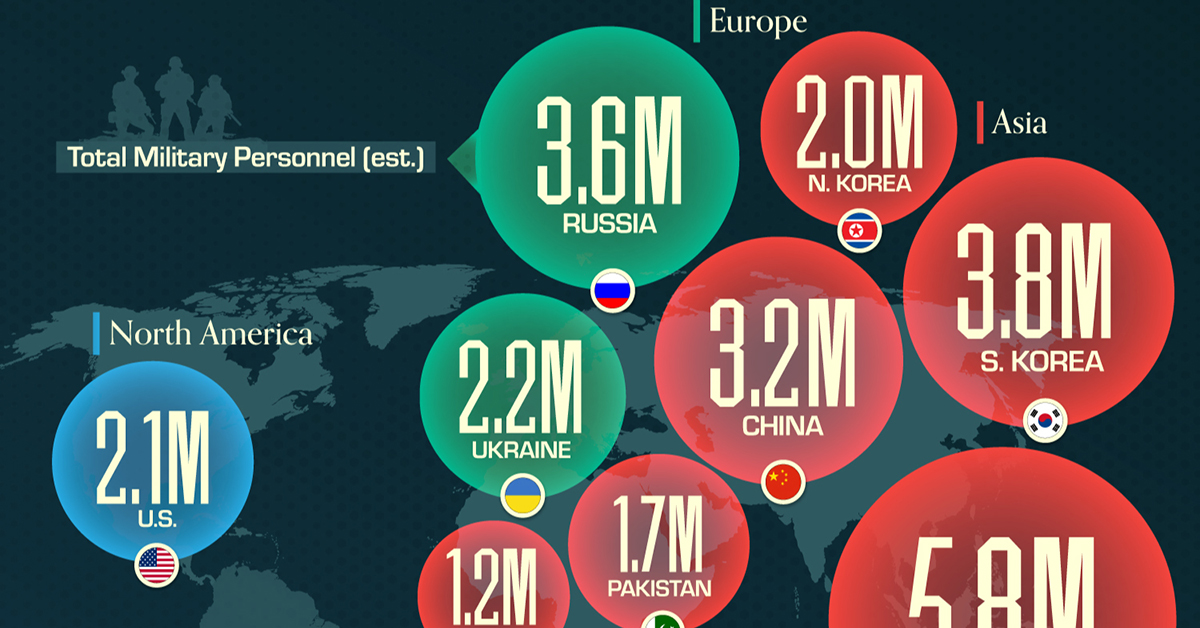
Mapped: The World’s Largest Armies in 2024
This was originally posted on our Voronoi app. Download the app for free on iOS or Android and discover incredible data-driven charts from a variety of trusted sources.
Despite being considered the biggest military force in the world, the United States doesn’t have the largest army in terms of personnel.
This graphic shows the top 10 countries by military personnel as of May 2024, including active and reserve personnel, as well as paramilitary forces. It is based on estimates from GlobalFirepower.com.
Vietnam, India, and South Korea Have the Biggest Armies
China has the largest standing army, with over 2 million active personnel. With increasing defense spending over the last decades, the country also ranks third in the number of tanks and second in the number of aircraft carriers in service.
When reserve personnel are included, however, the Chinese military falls behind those of Vietnam, India, South Korea, and Russia.
Vietnam’s forces include 600,000 active personnel and over 5 million in reserve. This is because Vietnam, along with countries like South Korea and Israel, has a standing policy of conscription for young adults.
| Country | Total Military Personnel (est.) | Region |
|---|---|---|
| 🇻🇳 Vietnam | 5.8M | Asia |
| 🇮🇳 India | 5.1M | Asia |
| 🇰🇷 South Korea | 3.8M | Asia |
| 🇷🇺 Russia | 3.6M | Europe/Asia |
| 🇨🇳 China | 3.2M | Asia |
| 🇺🇦 Ukraine | 2.2M | Europe |
| 🇺🇸 United States | 2.1M | North America |
| 🇰🇵 North Korea | 2.0M | Asia |
| 🇵🇰 Pakistan | 1.7M | Asia |
| 🇮🇷 Iran | 1.2M | Middle East |
Interestingly, the 2022 Russian invasion of Ukraine resulted in a massive increase in Ukrainian personnel numbers. Active personnel rose from around 170,000 in 2016 to over 900,000.
Despite not having the largest army, the U.S. accounts for almost 40% of global military expenditures, with its 2022 spending totaling $877 billion.
China ranked second in absolute terms, accounting for another 13% of world military expenditure at $292 billion.
-
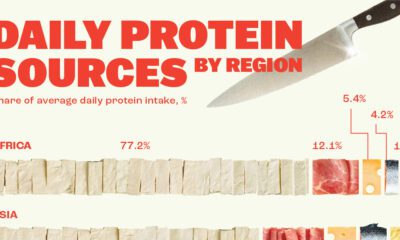
 Healthcare1 week ago
Healthcare1 week agoVisualizing Daily Protein Sources by Region
-

 Globalization2 weeks ago
Globalization2 weeks agoMapped: The Top Exports in Asian Countries
-
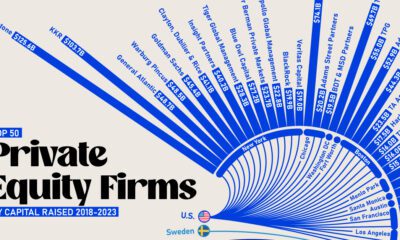
 Finance2 weeks ago
Finance2 weeks agoRanked: The World’s 50 Largest Private Equity Firms
-

 United States2 weeks ago
United States2 weeks agoMapped: The 10 U.S. States With the Lowest Real GDP Growth
-

 United States2 weeks ago
United States2 weeks agoComparing New and Current U.S. Tariffs on Chinese Imports
-

 China2 weeks ago
China2 weeks agoWhich Countries Have the Most Economic Influence in Southeast Asia?
-

 Demographics2 weeks ago
Demographics2 weeks agoThe Top 25 Nationalities of U.S. Immigrants
-

 Countries2 weeks ago
Countries2 weeks agoRanked: Countries Where Youth are the Most Unhappy, Relative to Older Generations





